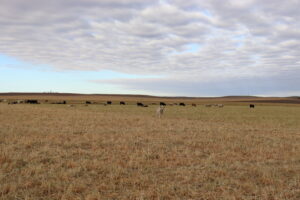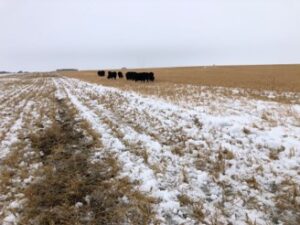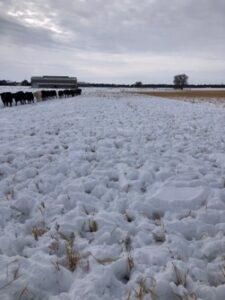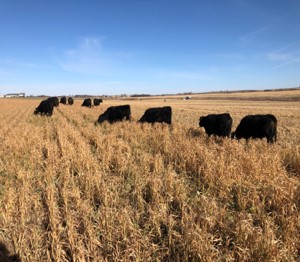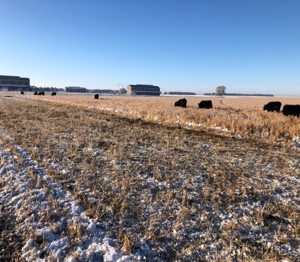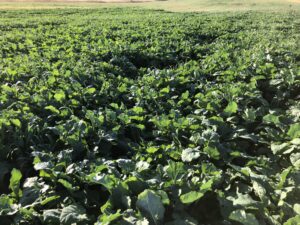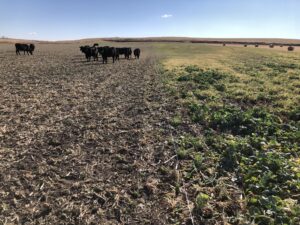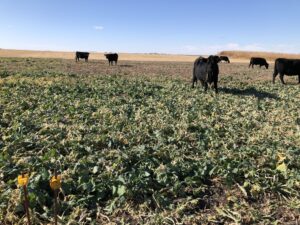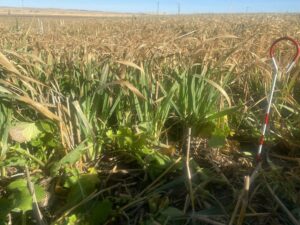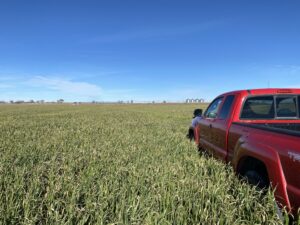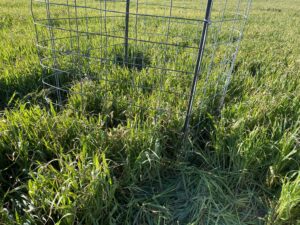Final report for ONC20-076
Project Information
Annual forages/cover crops can be used to fill the grazing gap in between perennial pasture in the fall and start of corn residue grazing. Currently, small cereal grains, warm season grasses, and brassicas are all commonly planted in the summer for fall/winter grazing. The cool season species (small cereals and brassicas) typically produce less forage than the warm seasons but are higher in quality. Grazing management is a key component that impacts the profitability of grazing these annual forages. Strip grazing can increase forage utilization by allocating animals to a smaller portion of a larger paddock for relatively short times. When compared to continuous grazing, strip grazing has been shown to result in greater harvest efficiency and thus allowing more grazing from the same acres in perennial grass systems. However, this usually comes at the cost of reduced forage selectivity and thus reduced individual performance, such as reduced average daily gain for growing calves. There is also an increase in labor needed to move fence with strip grazing. Thus, a series of on-farm experiments were conducted over two growing seasons (2020 and 2021) in Nebraska to evaluate the effects of strip grazing on cattle performance when utilizing various annual forage resources during the late fall and winter. Strip grazing increased carrying capacity by an average of 47 ± 15% and gain per acre by 44 ± 5% compared to continuous grazing though significant variability in the amount of increase was observed. This variability can likely be attributed to forage type (quality), frequency of moves, and forage allowance. Overall, strip grazing can be a valuable tool to increase carrying capacity when grazing summer planted cover crops during the fall and winter.
- Demonstrate establishment practices in a cropping system for fall grazing forage cover crops and techniques to increase harvest efficiency.
- Collect and evaluate forage and animal performance data on replicated, partnering producer sites to measure the impact of stocking density on fall grazed forage cover crops.
- Educate producers, industry, and peers about optimal establishment and utilization of forage cover crops with field days, cooperating producer demonstration sites, social and traditional media outreach, professional publications and presentations.
Cooperators
Research
Research was conducted at 5 locations across the state of Nebraska. One location in eastern NE had three groups of cattle that grazed their paddock continuously (CONT) and three that were strip grazed (STRIP) in each of the two years, while the remaining 4 locations each had one group that was continuously grazed and one group that was strip grazed. One of these four locations had data collected in both years and the other three only had data collected in a single year. The eastern NE location had replication within year, but used different forage types in each year. Thus, these data were analyzed to compare the effects of grazing management within year at the eastern NE location. To analyze the effect of grazing management across all locations, a pooled analysis (n = 7 site years) was conducted in which the data for the eastern NE site was combined within treatment and year, such that all site years had a similar statistical weight in the analysis.
Eastern Nebraska Year 1: Oats and Brassicas
Just prior to planting on August 12, 2020, a herbicide was applied to control weeds that grew after spring oats were harvested. Then the 93 irrigated field was no-till drilled with 50 lb/ac of Jerry oats and 3 lb/ac of Trophy rapeseed. Post emergence, nitrogen was applied at a rate of 38 lb/ac. The field received 1.6 ac-inches of water through a pivot during growth of the cover crop. The field was divided into 6 paddocks split between 2 treatments for a total of 3 replicates per treatment. Treatments were arranged in a completely randomized block design where paddock was the experimental unit. Paddocks were separated into 3 blocks with 2 blocks containing only irrigated land and 1 block which included dryland corners.
Steers (n = 84) were stratified by initial body weight (524 lbs) and assigned to 1 of 6 groups (n = 14 per group) that were assigned to a paddock. Seven of the 14 steers in each group were designated as testers and used to measure animal performance. Grazing began on November 12, 2020 and was terminated on February 3, 2021 (83 d) when the average forage height of CONT was 2 inches. The STRIP treatment groups were given access to new forage twice weekly, with a target of 2 inch post-grazing height and cattle were not back fenced. Steers grazing continuously had access to 15.5 ± 0.01 acres (1.11 acre/head) while STRIP calves used 8.5 ± 1.36 acres (0.60 acre/head).
Prior to grazing, forage was clipped at ground level and sorted by species to determine forage biomass and quality. Four locations (3 x 2 ft) in each of the irrigated paddocks and 5 locations of the paddocks containing the dryland corners were clipped (3 from the irrigated and 2 in the dryland portion of the paddock). On days 21, 41, and 70 of grazing, biomass was clipped again from 4 locations in each of the CONT paddocks. On these days, 2 locations were clipped in the strip that would be allocated and 2 locations from the grazed strip that was previously sampled for pre-graze biomass were taken to allow for a more accurate estimate of disappearance. No final biomass clippings were able to be collected as steers from an adjacent field grazed in the experimental paddocks prior to sample collection.
Forage samples were then dried for 48-72 hours in a 60º forced air oven to determine biomass and analyzed for crude protein (combustion method) and digestible organic matter (DOM) to determine quality. The DOM was determined by incubating samples in buffered rumen fluid for 48 hours to determine invitro organic matter digestibility (IVOMD) and then multiplying that by the organic matter content of the sample. This serves as a evaluation of the energy content of the forage and is a proxy for total digestible nutrients (TDN).
To determine the economics of grazing a partial budget analysis was conducted. Costs included seed ($10.80/ac), seeding ($12.00), irrigation ($15.02/ac), nitrogen fertilizer ($15/ac) and application ($8.75/ac), herbicide ($18.77) and application ($7.00/ac) and temporary perimeter fencing ($5.00/ac). Labor for moving the STRIP fence was charged at $20/hr and 0.5 hr per move per group ($28.04/ac). In total, continuous grazing costs were budgeted at $92.34 per acre while strip grazing was $120.38.
Eastern Nebraska Year 2: Diverse Annual Mix
In mid-July after wheat harvest, a 17 species mix which included warm and cool season grasses, legumes, and forbs was planted on 60 ac of irrigated land. No irrigation or nitrogen fertilizer was applied. The field was divided into six, 10 ac paddocks that were blocked by location in the field and treatment (CONT or STRIP) was randomly assigned to paddock within block for a total of 3 replicates per treatment. Paddock was considered the experimental unit. The STRIP groups were allocated forage approximately twice a week, with new strips provided when approximately 40% of the forage had disappeared.
Steers (n = 60) were stratified by initial body weight (635 ± 0.71 lb) with 10 steers assigned to each paddock. Grazing was initiated on December 9, 2021 and terminated on February 1, 2022 when the average forage disappearance of the CONT was approximately 40% of the biomass. Steers grazing continuously had access to 9.99 ± 0.01 acres (1 acre/head) while STRIP calves used 7.16 ± 1.21 acres (0.72 acre/head).
Forage clippings for biomass and quality analysis were collected prior to grazing initiation (pre-graze) and clippings for biomass analysis were collected following grazing termination (post-graze). Each paddock was divided into 5 equal parts and biomass was clipped from a random location (3 feet by 2 feet area) with each of the five zones. Following collection, forage samples were sorted by functional type and pre-graze samples were analyzed as described previously.
A partial budget analysis was again conducted to determine the economics of grazing. Between treatments, costs kept consistent in the budget included seed ($50.00/ac), seeding ($12.00), and fence ($5.00). Expenses applied only to STRIP paddocks included labor for moving the STRIP fence and was charged at $20/hr and 0.5 hr per move per group. In total, continuous grazing cost $67.00/ac while strip grazing cost $85.16/ac.
Pooled Analysis: Stockpiled Mixes Across Nebraska
A total of 4 additional locations, across 2 years were utilized for a total of 5 additional site years of the comparison of CONT to STRIP grazing of stockpiled cover crops. An oat brassica mix (purple top turnips or rapeseed) were planted on 4 of the 5 site years with the remaining site year being planted to a mix of forage sorghum, radish, turnip, pea, vetch, rye, oat, and sunflower. Cows were utilized on 4 of the 5 site years with the remaining utilizing developing heifers. Grazing was initiated in the fall and was terminated when the producer felt that forage was limited.
Eastern Nebraska Year 1: Oats and Brassicas
The initial forage biomass was predominantly oats with the rapeseed comprising about a quarter of the forage available. Both species were relatively high in energy with the rapeseed having almost double the amount of CP of the oats. The amount of forage (initial biomass) and energy content (DOM, % DM) of the forage offered were not different (P ≥ 0.58) between CONT and STRIP (Table 3). As designed, the initial BW of steers did not differ (P = 0.54) between treatments. Following grazing termination STRIP steers were lighter (P = 0.01) and due to lesser ADG (0.31 lb/d) than CONT steers. However, the STRIP calves were allotted about a third less acres per calf compared to control calves. Consequently, STRIP had increased (P = 0.03) carrying capacity with 82% more AUM/ac and increased gain per acre (P = 0.02) with 56% more lbs of gain/ac than CONT. Though numerically there was a 10-cent decrease in cost per pound of gain for STRIP calves compared to CONT, this was not statistically significant (P = 0.11). This indicates that even though strip grazing might be more expensive on a dollars per acre basis, the additional gain will pay for the extra labor at a minimum.
Eastern Nebraska Year 2: Warm Season Annual Mix
Though 17 species were seeded, biomass composition predominantly consisted of pearl millet, german millet, browntop millet and sunflower. At the start of grazing the german and browntop millets had fully developed seedheads with hand plucked samples containing 32% and 20% starch (DM basis), respectively. The sunflower heads had started to fill with seed and hand plucked samples contained 7.5% fat (DM basis).
Initial and final biomass were not different (P ≥ 0.44) between treatments. Calves were allowed to be selective with a target disappearance of 40% of the total biomass. Steers selected the sunflower head with no heads remaining post-grazing and grass seedheads with the majority (78%) disappearing in the grazed areas. Following the disappearance of the reproductive structures, calves appeared to select forbs and legumes then cool-season grasses. Disappearance (lb DM/AUM) was not different (P = 0.28) between CONT and STRIP.
The initial BW, final BW and ADG of steers did not differ (P ≥ 0.55). The carrying capacity (AUM/ac) tended to be increased (P = 0.10) by 43% in STRIP whereas gain per acre was increased (P= 0.02) by 31% for STRIP over CONT. The cost of gain did not differ (P = 0.56) between treatments, again suggesting the increased harvest efficiency can pay for the increased labor.
Eastern Nebraska Year 1 vs. Eastern Nebraska Year 2
When grazing the oat/brassica mix in year 1, ADG of steers in the STRIP was reduced (16%) compared to the CONT. However, there was no difference in ADG between treatments, although there was a numerical decrease (6%) in the STRIP. This difference in individual animal performance response could be a result of the greater forage quality found in the oats and brassica mix (73% DOM and 10.3% CP) compared to the 17 species mix (54% DOM and 6.9% CP) which resulted in higher gains in year 1 than year 2. It is also important to note that the steers grazing the 17 species mix in year 2 were allowed to be more selective due to lower overall forage quality than year 1 when a high quality forage was used. The benefit of strip grazing appeared to be greater in year 1 when there was a greater quantity and quality of forage available than in year 2.
Pooled Analysis: Stockpiled Annual Forage Mixes
Initial biomass varied greatly between sites and years, but the average initial and final biomass was not different between CONT and STRIP. The STRIP treatment had greater (P = 0.02) carrying capacity (AUM/ac) compared to CONT. In fact, across all the sites strip grazing increased carry capacity by 47%, although this varied substantially ranging from an increase of 12% in one site year to 118% at another. Statistically, there was no difference (P = 0.20) in forage disappearance (lb DM/AUM) between the STRIP and CONT, although across sites STRIP numerically reduced disappearance per AUM by 53%. The expected intake per AUM is 702 lb of dry matter. This means that STRIP only lost an estimated 8.5% of forage to trampling loss compared to the CONT treatment which lost an estimated 57%.
Educational & Outreach Activities
Participation Summary:
Research results were presented as posters and presentations at several educational events including the American Forage and Grassland Council Annual Conference, Nebraska Cattlemen's College, Nebraska Sustainable Agriculture Society Conference, Driftless Region Beef Conference, and the Haskell Ag Lab Forage Field Day. One of the cooperating producers shared their perspective on how cover crops fit their system as well as the benefits of strip grazing cover crops in the fall in a webinar. Results of the on-farm research were also presented during the webinar to 32 participants and the recording has received over 250 views. A roundtable discussion with one of the cooperating producers was recorded as a BeefWatch Podcast, which has over 1,280 downloads.
Learning Outcomes
Project Outcomes
Increased utilization of simple cropping systems in the Midwestern United States has led to concerns regarding
long term sustainability, with problems of soil erosion, nitrogen leaching, increased runoff, and overall lower
soil health. Diversifying these systems with forage cover crops addresses these issues by providing longer
periods of active plant growth, increased biodiversity, soil cover, and positive soil and nutritive effects.
However, adding annual forage cover crops burdens the producer with increased costs of establishment and
labor. With high nutrient potential, producers overcome these barriers by utilizing these forage cover crops as a
high quality feed source for cattle during the fall/winter grazing gap.
Strip grazing increased carrying capacity and gain per acre when compared to continuously grazing stockpiled annual forages in the fall/winter. Strip grazing forages of higher nutritional value seem to provide greater gain on the same number of acres when compared to strip grazing forages of lower nutritional value. Variability in the response to strip grazing may be attributed to forage type, stocking density, frequency of moves, and how selective cattle are allowed to be when grazing (forage allowance). Overall, strip grazing can be a valuable tool to increase carrying capacity when grazing summer planted cover crops during the fall and winter.
A better understanding of how stocking density and grazing method affects grazing efficiency
supports sustainability and land stewardship, while providing economic viability to the producer. This increases
the opportunity for young family members to return to operations and maintain a valued rural lifestyle.
Three of the cooperating producers completed a post-survey about their experience grazing fall forage cover crops. When asked about the advantages and disadvantages of strip-grazing, a producer from southwest Nebraska commented, "Strip-grazing gives you more control of the amount of forage harvested and residue left behind. Although it requires more time and labor moving fence, it is worth it for the increased forage utilization. It forces you to spend more time in the field observing the livestock, soil, and plants." All three producers stated that they plan to continue strip-grazing cover crops while making minor adjustments to best fit their system. A producer from northeast Nebraska commented, "Strip grazing is as much about caring for the land as the livestock. My philosophy is the animals are a tool you can use to care for the soil. If you take care of the land, it will take care of you back."
